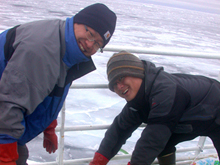
At the northernmost station of the 2009 RUSALCA expedition, Sang Heon Lee and Hyoung Min Joo make sure the open-air water baths, where phytoplankton incubate in bottles, are not frozen solid. Click image for larger view and image credit.
Phytoplankton Productivity in the Chukchi Sea
September 29, 2009
Sang Heon Lee
Senior Researcher
Korea Polar Research Institute
Our group, consisting of myself and Hyoung Min Joo from the Korea Polar Research Institute (KOPRI), and Terry Whitledge and Michael Kong from University of Alaska – Fairbanks (UAF), is estimating how much primary production is produced by phytoplankton in this area. Phytoplankton (tiny free-floating photosynthetic organisms) is a very important basic food source in the marine ecosystem. In recent years, many different environmental conditions that affect phytoplankton growth have changed in the Arctic Ocean.
The Chukchi Sea is the only conduit between the North Pacific Ocean and the Arctic Ocean, and some previous studies have found that phytoplankton productivity in the Chukchi Sea has declined significantly, compared to a few decades ago. To find whether decreasing productivity is a general trend in this region or not, it is important to collect more field data from a wide range of the area. The Russian side of the Chukchi Sea is especially important to sample, because there is not much data about this area.
Our first experiment is estimate phytoplankton productivity. At each station, we collect seawater from Niskin bottles mounted to the rosette. We take water samples from six different light depths — 100%, 50%, 30%, 12%, 5%, and 1% — the whole range of the euphotic zone, which receives enough light for phytoplankton can grow. Taking samples at different levels allows us to integrate the total production of phytoplankton throughout the entire water column. Once we have the six samples of seawater, which contain phytoplankton, we put the samples into incubating bottles and add small amounts (1 milliliter) of stable isotope solutions as tracers for phytoplankton production.
Then, we place the incubating bottles in the on-deck water baths in natural sunlight for three to four hours, and as the phytoplankton photosynthesize and grow, they absorb the isotopes at a rate we can estimate. After the incubation, we will filter out the water and preserve the phytoplankton on a glass fiber filter for comparison to a “control” (natural) phytoplankton sample, which was not incubated, from that station. In this way, we determine the phytoplankton production, or how much phytoplankton produce organic carbon material. This analysis is undertaken using the mass spectrometer at the UAF; analysis of each sample costs $24.
At each station, we also collect three samples of water for a macromolecular productivity experiment, which tells about the physiological and nutritional condition of phytoplankton. It is important to know about the condition, or quality, of phytoplankton, because it is such an important part of the marine food web, and most of organisms rely on phytoplankton for their own survival. If the condition of the phytoplankton is not good, species that feed on phytoplankton, and subsequently higher trophic levels of animals, might also be affected. So, we chemically analyze the samples of phytoplankton to look at their compositions of macromolecular-level products — such as lipids, proteins, polycarbonates, and low molecular weight metabolites — and make a determination about the status of the phytoplankton.
Additionally, at many stations we also take samples at six different depths so we can identify the dominant phytoplankton from each station. As soon as we have the sample, we add a chemical that “fixes” the phytoplankton in shape, filter out the water, and use a glue-like chemical to stick the phytoplankton to a glass slide. When we are back in the KOPRI laboratory, we will examine these slides and determine which phytoplankton species are dominant in different areas we visited.















